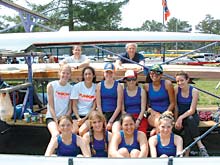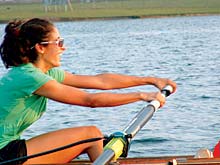Asheville has long been in the spotlight as a top spot for such outdoor activities as trail-running, mountain-biking and kayaking. But whoever heard of rowing here?

And no, this isn’t going out with grandpa in his rickety wooden jon boat on a Saturday afternoon. In fact, on the old man’s best day—even with a boost from his prized twin electric motors—he could only dream of keeping up with a real rowing crew. Eight to a boat, these athletes churn and burn across the water in sleek, carbon-fiber shells.
The Asheville Rowing Club’s roughly 35 adult co-ed members keep a fleet of racing boats in a shed by Lake Julian. Graceful and light, they hang neatly against the boathouse walls and dangle from the ceiling. Bought new, these 250-pound beauties would cost nearly $15,000 apiece. Their long, cloud-white shells are shallow and narrow from bow (front) to stern (back). “Riggers,” metal triangles that support the oars, are bolted along the gunwales (the boat’s upper rails) along with the oarlocks.
One of the boats is reserved for the club’s nascent Girls’ Junior Rowing Program, which currently consists of 14 girls, ages 13 to 18. The program’s coach, Jack Gartner, hopes his team will grow to 25 by year’s end.
“They’ve already competed in the Southeast Youth Championship Regatta (held in Clemson, S.C.) and Lanier Sprints (in Gainesville, Ga.),” said Gartner. “This fall we’re planning to go to the ‘Head of the Tennessee,’ held in Knoxville, Tenn.” Throughout the year, the Asheville Juniors will compete with other regional youth programs based in Charlotte, Raleigh and Wilmington as well as Columbia, S.C.; Augusta, Ga.; and Oak Ridge, Tenn.
The cost to participate is $240 per year or $120 for a half-year, which includes the use of boats and coaching. There are additional charges for uniforms and event fees, but this is a nonprofit mission, and Gartner says the club’s goal is to open up the sport to everyone who’s interested, even if they can’t afford to pay full price.
The girls practice several times a week, varying their training routines depending on race dates and seasonal goals. Practice begins on a short wooden dock on Lake Julian. The coxswain (who steers and directs the crew) is seated in the stern of the boat, equipped with a microphone that broadcasts to three separate speakers mounted in the inner hull.

Before a recent practice, the girls stood ready at the starboard side of their craft, looking like ordinary teenagers in shorts and T-shirts. A few of them laughed and joked. At the coxswain’s command, they boarded. Once settled in their wheeled seats (designed to move with their occupants’ back-and-forth motions), they strapped their feet in and locked down their oars.
Coach Gartner cranked up his small motorboat, or “launch,” and headed out as the girls moved their own vessel into the day’s glassy waters and cool air.
Lengthwise, the boat resembled a giant mechanical top-water insect. A medley of bobbing heads and shoulders formed a spiny middle, while long outstretched oars resembled twiggy legs, simultaneously plunging into and pawing at the dark water below. And like a spider’s silk thread, the boat left a fine wake behind—the only evidence that it was ever there.
The coxswain called for a “power 10,” and the rowers stroked as hard as they could, simulating a race situation.
Competitions, said 15-year-old Katie Myrick, can be “nerve-wracking.”
“Every race is different,” she continued. “Weather is a big factor. If the wind is not in your favor, it will blow you across the course and out of your lane. Races are about seven minutes long, and you have less than a minute to prepare. It’s hard, but fun. It’s different than all other sports we could do as high-school students.”
The girls meant business. Their legs extended and quads rippled as they pushed back in their seats. Toned shoulders contracted in unison as oars sliced the water. Gartner buzzed around in his launch, giving orders: “Look straight ahead. Pull it through; 90 percent is in the legs.”
Later, he explained: “We teach these people how to row and work together as a team. All individuals create one.”
Emily Cid, 16, described the team as “one family.” Olivia Wilson, 15, who joined the team last September, agreed, saying, “The social aspect is a lot of fun. A lot of girls have made a lot of friends out here.”
The junior rowers and their supporters don’t expect mobs of spectators to line the shores. But they do hope to attract the attention of top schools like Princeton, Harvard, Yale and Duke, which recognize that rowing helps build character. Gartner’s daughter was recruited by Princeton’s rowing team some time ago, and Cindy Stevens, another coach, said that it’s good to “bring girls in early. Rowing on resumés makes them look good.”
Coach Gartner knows that while rowing can be tough, it teaches commitment and creates focus. Moreover, anyone can do it. “The main thing,” he says, “is that you don’t have to have prior athletic experience.”
Elizabeth Muse, at 13 the team’s youngest member, says her rowing skills are drawing on unexpected sources. “I’m even using what I learned in ballet to balance myself better in the boat,” she says.
[Jonathan Poston can be reached at www.prnut.com]
To learn more about the Girls’ Junior Rowing Program, visit www.ashevillerowing.org



Before you comment
The comments section is here to provide a platform for civil dialogue on the issues we face together as a local community. Xpress is committed to offering this platform for all voices, but when the tone of the discussion gets nasty or strays off topic, we believe many people choose not to participate. Xpress editors are determined to moderate comments to ensure a constructive interchange is maintained. All comments judged not to be in keeping with the spirit of civil discourse will be removed and repeat violators will be banned. See here for our terms of service. Thank you for being part of this effort to promote respectful discussion.